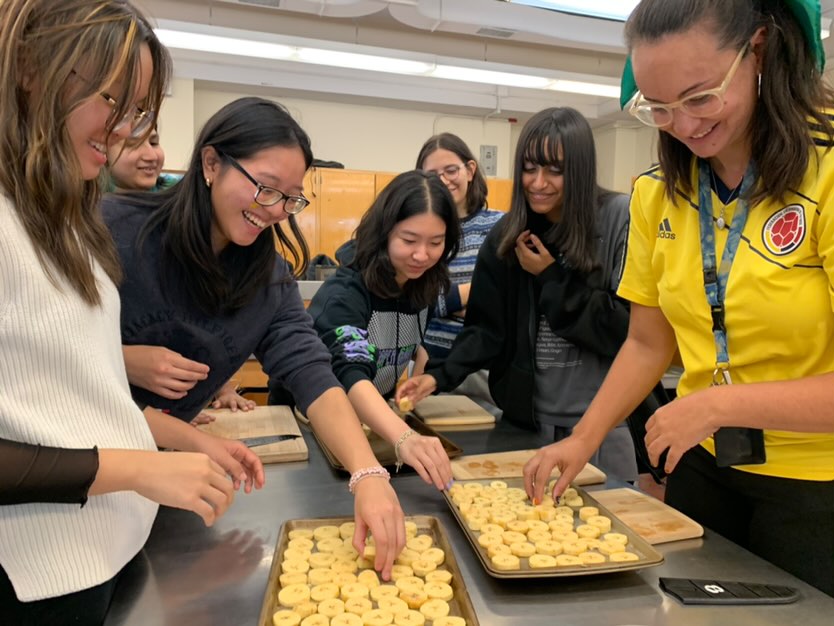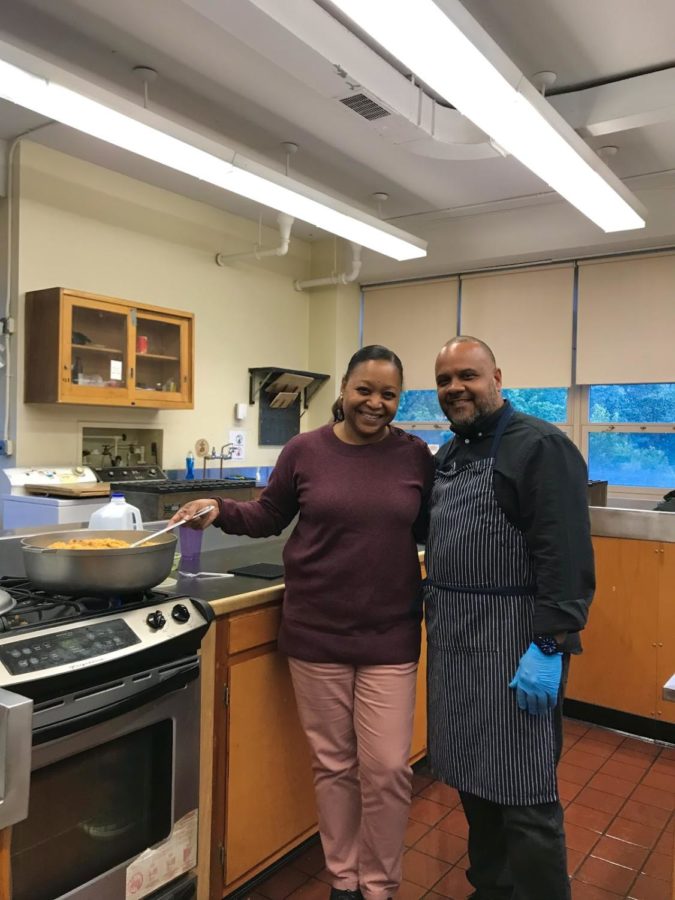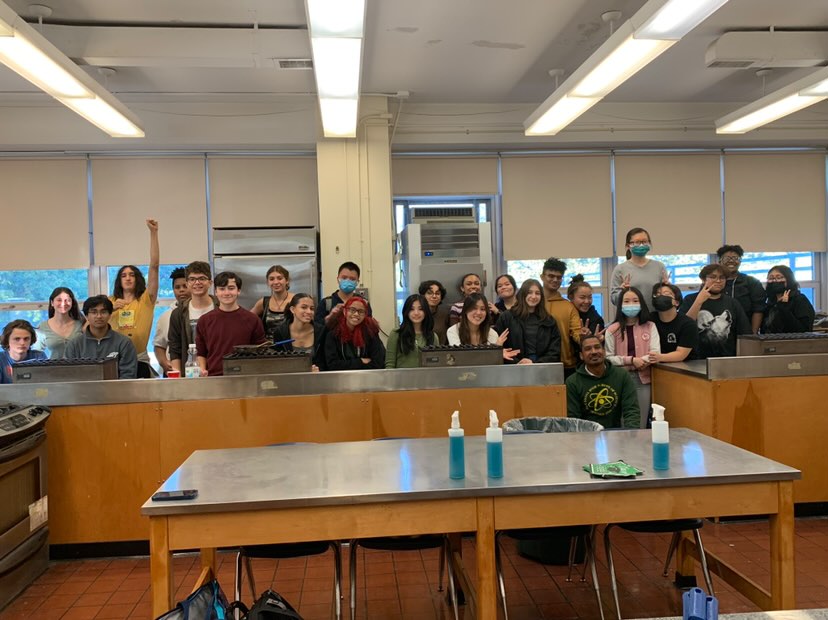Bronx Science Celebrates Hispanic Heritage Month
A brief history of how the month became official, and how Bronx Science has come to celebrate it this year.
Ms. Perez stated, “I also like sharing my culture with students, the community, and more importantly with my children. My daughter is now old enough to understand our background in a general sense. She is also aware that she is Hispanic and knows about the month we are celebrating.”
Walking to first-period class accompanied by music over the loudspeakers is not an unusual occurrence for most Bronx Science students. However, on Friday mornings throughout September and October 2022, students found themselves listening almost exclusively to Spanish songs. Although most Bronx Science students cannot speak Spanish, songs by Spanish-speaking artists have become increasingly popular in recent years.
Special morning music is just one way that Bronx Science celebrated Hispanic Heritage month. It may seem like a small tribute to such a diverse culture, but it served as a consistent reminder of what the month celebrates and reminded students to appreciate diverse cultures.
Hispanic Heritage celebrations from September 15th through October 15th, 2022, would have been impossible without the contributions of the S.O. Cabinet – Bronx Science’s student governing body. Its Hispanic Heritage Month Chairs worked hard to make all of the events successful. They arranged the loudspeakers to play Hispanic/Latinx music every Friday morning, showcased a book display in the library with Hispanic/Latinx authors, and hosted an in-person cooking series aimed at sharing the rich Hispanic/Latinx food culture.
Lili Matta ’23, one of the Hispanic Heritage Month Chairs, shared what the month means for her: “It’s a dedicated time to celebrate Hispanic and Latinx people’s contributions and culture. Personally, it’s a time for me to remember all of the efforts and contributions my family made over generations that led to me being in the place I am today.”
People all around the country have been celebrating the month of Hispanic Heritage for decades, though this wasn’t always the case. The month was originally only a week-long celebration started by President Lyndon B. Johnson in 1968, who stated in the proclamation that set this into motion: “Wishing to pay special tribute to the Hispanic tradition…the Congress…has requested the President to issue annually a proclamation designating the week including September 15 and 16 as National Hispanic Heritage Week.”
Johnson emphasized that American citizens “of Hispanic descent are the heirs of missionaries, captains, soldiers, and farmers who were motivated by a young spirit of adventure, and a desire to settle freely in a free land. This heritage is ours.”
On August 17th, 1988, President Ronald Reagan extended the week-long celebration to a full 30 days, spanning from September 15 to October 15. In his remarks on signing the National Hispanic Heritage Week Proclamation, he praised Colonel Gil Coronado of the U.S.A.F. for his painstaking efforts, “I’m honored to welcome Colonel Gil Coronado [USAF]. Due to his efforts, we’re not just here to celebrate Hispanic Heritage Week but to announce that in 1989 the period between September 15th and October 15th will be Hispanic Heritage Month. It’s an honor well-deserved. And you can thank Colonel Coronado, who’s been a stout defender of his Hispanic heritage and the United States of America.” After almost three years of lobbying, Coronado was finally able to persuade Congress to dedicate the 30-day period to the celebration of the contributions of Hispanics to America.
Reagan continued, “Yes, we gather to salute the Hispanic heritage. It’s not only the heritage of these 19.4 million Americans of Spanish-speaking descent, it’s part of my heritage, too, and my family’s heritage and the heritage of every American as well. We have all been enriched by the contributions of Hispanics in every walk of American life.”
Many Americans are confused as to why Hispanic Heritage Month is not set as a full calendar month. On September 15, the Central American countries Costa Rica, El Salvador, Guatemala, Honduras, and Nicaragua celebrate the anniversary of claiming their independence from Spain. Other countries such as Mexico and Chile celebrate their independence days within the 30 days after this date. Johnson stated that Congress kept each of these dates in mind when designating the dates for Hispanic Heritage week, and later the month, as well as the fact that these dates should be celebrated in America “with appropriate ceremonies and activities.” Having the celebrations start on such a significant date, and extending them to a full month after, allows those celebrating their own countries and culture to share the joy with those around them for much longer.
The theme for this year’s Hispanic Heritage Month was “Unidos: Inclusivity for a Stronger Nation,” an earnest vocation in the aftermath of COVID-19’s devastation as well as social and political upheavals that have stirred up much division in our nation. Among parades, festivals, and volunteering events, the possibilities for celebration have become endless.
At Bronx Science, these festivities have expanded throughout the years to spark more community engagement. In the library, Hispanic/Latinx authors are featured on the monthly-rotating book display at the front of the hall. This allows students to peek into the diverse world of Hispanic literature, and the selection of books serves as a symbol of appreciation for the culture and language of focus.
In-person events at Bronx Science have always offered important opportunities to connect with our peers, and they are understandably even more popular after the pandemic. During the Hispanic Heritage Month celebrations this year, the extremely popular cooking series was a success, uniting students from all grade levels to learn the diverse culinary techniques of Hispanic/Latinx culture taught by the Bronx Science faculty.
The first cooking event was hosted by Ms. Lozano, a Spanish teacher at Bronx Science. Students were able to make and eat tostadas de pollo, a dish that consists of chicken and various other toppings that are prepared separately and served on a flat tortilla. Though the recipe is not the simplest, students were able to follow along and enjoy their creations with the help of their experienced teacher. This event formally kicked off celebrations for the month.
One of the Bronx Science guidance counselors, Ms. Rosado, was joined by her husband and hosted the next cooking event, demonstrating how to make arroz con gandules, or rice with pigeon peas. Clearly explaining each step in the process, she made the vegetarian meal with expertise. As the rice steamed, the Rosados played trivia games to help the students get to know each other better. The experience was a joy to the fullest, allowing students to cook together and share the meal afterward.
Ms. Rosado is an avid supporter of the month’s celebrations and was thrilled to share part of her culture with students. Full of pride, she said, “Hispanic Heritage Month is an opportunity for all Hispanic/Latinx peoples in the U.S. to highlight their culture, traditions, and impact on the United States. Regardless of our ethnicities, each of our countries has had an impact or been involved in the history of the United States. It’s a beautiful diaspora that helps to make this country what it is today. We should celebrate and be proud!”
Ms. Perez, a mathematics teacher at Bronx Science, added, “I also like sharing my culture with students, the community, and more importantly with my children. My daughter is now old enough to understand our background in a general sense. She is also aware that she is Hispanic and knows about the month we are celebrating.” Ms. Perez hosted her own cooking event where she made patacones, which are plantains that are traditionally served with cheese, as well as fudge balls, called brigadeiros.
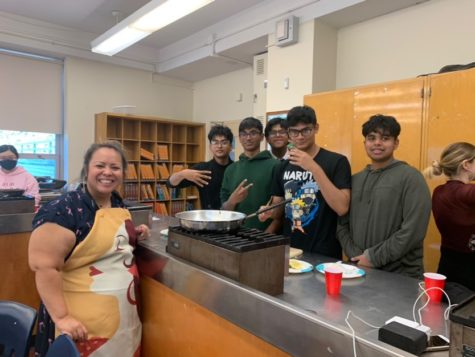
Señora Chuy, another Spanish teacher at Bronx Science, made camarones al ajillo, or garlic shrimp, for the next event. Though Hispanic Heritage Month may be seen as a time to exclusively celebrate Spanish-speaking countries, Señora Chuy said, “I am also of Chinese descent and there is a large Chinese influence in Cuba and the rest of the Caribbean and Latin America as a whole.” Her view supplements the belief that it’s important to take the time to learn about and appreciate how Hispanic culture has influenced and has been influenced by other cultures around the world.
Although the month officially ended on October 15, the celebrations continued. Mr. Gonzowitz led the final cooking event on October 20th, 2022, by making Tres Golpes, a dish traditionally made with plantains, frying cheese, salami induveca, eggs, and red onions.
In each event, students were able to eat the food after cooking, sharing a valuable moment with each other. If it weren’t for the cooking events being open to all students of every grade level, the students attending would most likely never have had a reason to interact with one another, and may never have spoken in any other situation. Thanks to these festive events, Bronx Science students were able to make connections and formulate new friendships as they enjoyed cooking and eating the foods they made together.
The main club that focuses on Hispanic and Latin culture at Bronx Science is Vivo Latino, where celebrations of this culture don’t stop after Hispanic Heritage Month. Their club meetings continue each week, full of lessons and activities. At these meetings, members come together to better understand the history of the Hispanic and Latinx populations around the world, as well as make connections with how the culture has changed to fit a more modern world. Whether it is through choreographing dances to traditional bachatas, or creating presentations about the distinctions between being Hispanic and Latinx, the president of the club, Genesis Sanchez ’23, loves how she can help bring people together and educate them through her culture.
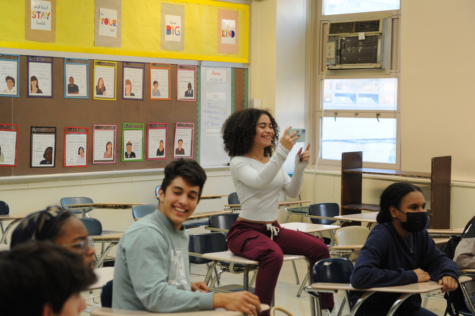
However, the vice president and dedicated member of the club, Stefan Inderbitzin ’23, offered a different, more critical perspective: “I am unsure about Hispanic Heritage Month. Part of me wants to love it. The month was enacted into law to celebrate the immense contributions of Hispanic people in America.”
Inderbitzin continued, “Even more so, the whole celebration feels somewhat insincere. How can the United States celebrate Puerto Rican culture when it allows Puerto Rico to be ravaged by hurricanes year after year? How can the United States celebrate Mexican culture when its ICE officers patrol the border, with the cause to detain and deport? Throughout the 19th, 20th, and 21st centuries, the United States benefited from the exploitation of Latin America and Latin Americans in the United States. Of course, the issues at play cannot be resolved quickly, and a Hispanic Heritage Month is beneficial. I will continue to celebrate Hispanic Heritage Month because it is better than nothing, but it is not enough. The month will never be truly meaningful to me until the United States and American businesses take true steps into bolstering the people that the many beautiful, Latin American cultures come from.”
Although the celebrations may seem a bit superficial, the increasing popularity and interest in the month have been a sign of progress. “I, myself, learned about figures such as Cesar Chávez, Frida Kahlo, and Sonia Sotomayor in elementary school because of Hispanic Heritage Month. For that reason, I enjoy Hispanic Heritage Month. That being said, the recurring figures mentioned during Hispanic History Month should be taught in school curricula,” said Inderbitzin.
Carlos Martinez ’26 contributed a reflection of his own experiences, “Hispanic Heritage Month is a month when I’m specifically encouraged to have pride in my own culture, regardless of tough times I have endured as a Boricua. It gives me ease to know that even through that trouble, there is at least one month when I can feel completely comfortable and even happy to be a part of this community. In this month, research and studies on Hispanic Americans from all across the world inspire joy and excitement in whoever is fortunate enough to learn about its topics. Additionally, just to have a month where people can appreciate my culture and at least try to understand its complex workings and ways is almost liberating and really shows the diversity of America and the foundation which millions of Hispanics helped to build.”
Matta also expressed pride in the celebrations of her culture, stating, “I am reminded when I speak with my grandparents about the sacrifices and contributions they made to our family and myself. I think it’s very important that Bronx Science students celebrate Hispanic Heritage Month. If a student was not able to attend any of the Hispanic cooking sessions, I recommend they still make the recipes on their own, go to a Vivo Latino meeting, research important figures like Sonia Sotomayor, and learn more about Hispanic/Latinx culture.”
“It’s a beautiful diaspora that helps to make this country what it is today, we should celebrate and be proud!” said Ms. Rosado.
Elizabeth Colón is a Copy Chief for ‘The Science Survey.’ Elizabeth finds that the most appealing aspect of journalistic writing is how much...
Lucas Melendez is an Arts & Entertainment Editor for ‘The Science Survey.’ He believes that journalistic writing is a vital means of communication,...

